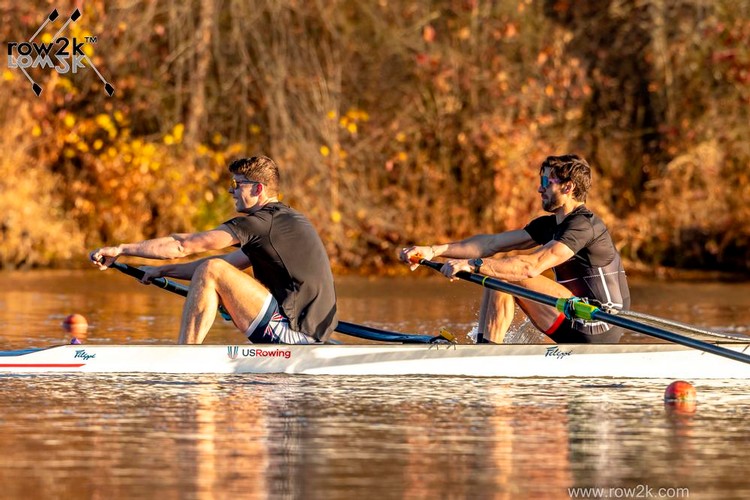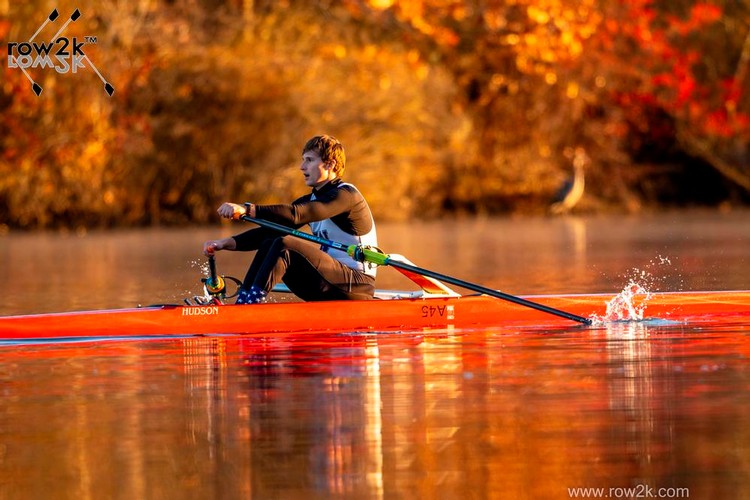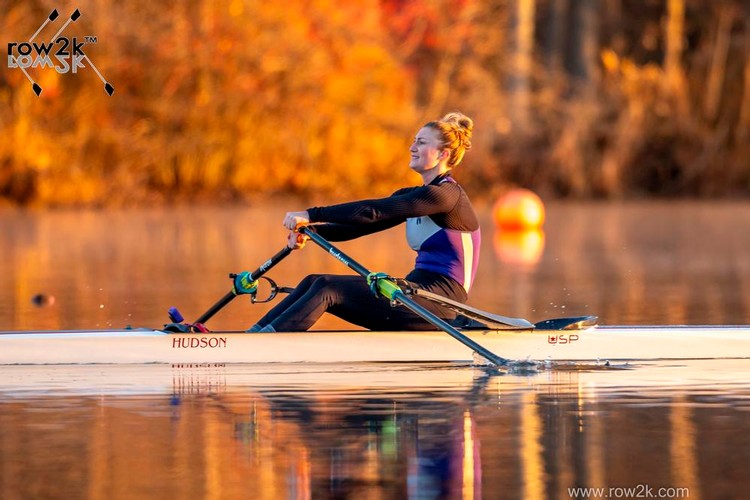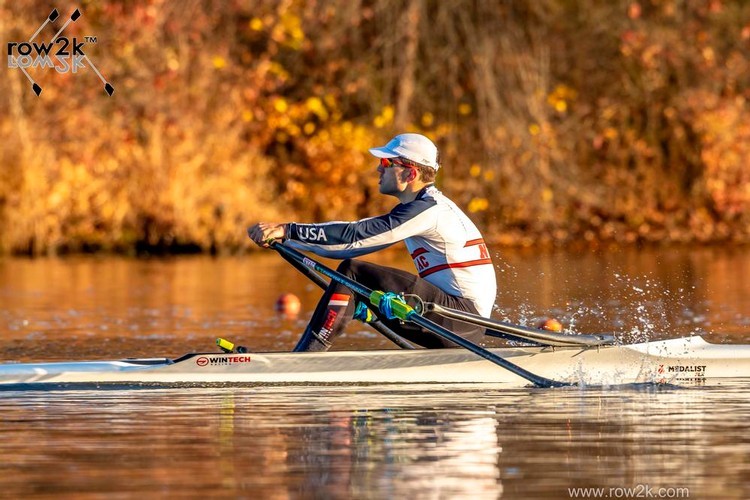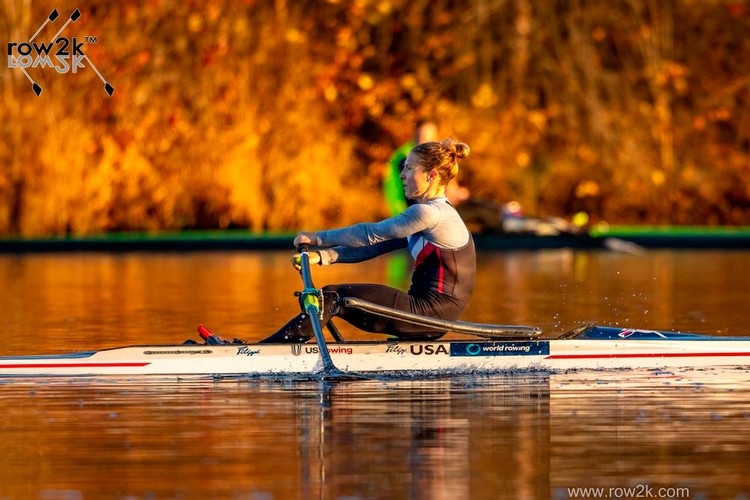
Olympic lightweight Michelle Sechser won the Women's Single at the Speed Order, which was held as a combined open weight/light weight event complete with weigh-ins for Sechser and the other light scullers angling to race in the Light Double at the Paris Games next year.
Sechser made the A Final in Tokyo with Molly Reckford, and then picked up her second LW2x silver medal of this quadrennial in Belgrade this year with new partner Mary Jones Nabel. She also won the Head of the Charles Champ Single--along with its new cash prize--in October.
You can watch row2k video here of Sechser racing the time trial.
row2k: So, how was it out there, doing a frosty 2k practically in the dark?
Michelle Sechser
It was a very early morning especially since there was a lightweight category, so the weigh-in opened up at 5:15, which is pretty cold and pretty dark.
It definitely feels a little different to be doing flat out 2k racing, with starts and everything, when it's 30 degrees with not much daylight but, honestly, it was a beautiful day for it. We ended up having just gorgeous flat water for the first couple of races of the day.
row2k: Was it good, for this Speed Order, having the lightweights mixed in and getting to race a fuller field?
Michelle Sechser
It did feel a bit funny, once Molly Reckford, Audrey Boersen and I all made the A final, to have three of us at the scale making weight, two hours before going and racing women who didn't have a weigh in. But it's all just attitude, and I think it's a great challenge to hold yourself accountable to prove your speed and strength at weight.
Like always with lightweights, going up against bigger, stronger athletes is nothing new to us. It was an interesting way to do it and I am glad that it wasn't sorted out, with the lightweights in a separate final, because I really wanted to go up against the top women in the country. Being able to be in the same final as them was a great opportunity.
You can even look at Liz Martin in the B final: she did the weigh in, made weight, and so she actually was the fourth fastest lightweight, even though she was in [a different] final.

row2k: How do see this racing and the success you had this weekend fitting into your overall trajectory towards, hopefully, Paris?
Michelle Sechser
From a training standpoint, this race doesn't exactly fit into what we've been doing here in Princeton on Josy (Verdonkschot)'s training plan. We've been doing a lot of endurance mileage, a lot of power per stroke work at low rate, things that are really typical for fall season training. What was interesting about the speed order was to more or less show up for the race and evaluate ourselves without having done a ton of peaking and pace specific work for it. We did a couple of five hundreds on Wednesday, but that was it. So it was a new challenge.
I think the bigger takeaway was less about what kind of speed I have over 2k right now, because the training plan isn't designed to really support that [now], but really just going through the experience of racing and practicing it. I've been working on specific technical changes at practice. Now when I go up to full press and that higher rate, I can see what sticking, what holds well for my technique and my rhythm. Of course, it's always good running through the practice of feeling that race day pressure, managing my weight, managing my headspace, and even learning to respond to different moves in the field. Even though I've been at this for many years, I don't think you can ever practice that enough.
They ran seven boat finals, which was new and really exciting, so I got to work on that experience. And, off the line, Emily Delleman was up and leading the field by about a boat and a half of open water and so for me, practicing in that moment to sit up, take a deep breath, commit to my technical points. It's all about going through that exercise of how to race the race and how to manage the thoughts and the technique while rowing as hard as you can down the course. I love that there was another chance this year to get to practice all that.
The Head of the Charles was similar, even though it's a different distance and a time trial and different people than I'll race at the Olympics, but going through that same process of rowing as hard as you can while also rowing well, and managing your race strategy. I love that this fall presented so many opportunities to keep practicing that, and to practice performing under pressure.
row2k: And presumably, each of those opportunities gives you a chance to get into different kinds of racing situations, right?
Michelle Sechser
Definitely, and on race day, you can't have preferences about, oh, I want a tail wind or I want a headwind, because the universe is going to throw all kinds of different conditions and race strategies at you. The field is going to race differently and the race will play out differently every single time you show up. So the best thing we can practice is just the ability to respond in the moment, to race your race, to hold your technique, to manage your pace and all those things. The more that you can practice different approaches and different races, it hones that ability to be super agile in how you perform each time.

This is more like being like the GC rider in the Tour de France: you don't have to be perfect at everything, but you can't be bad at anything. Whether it's the Charles, the Gold Cup, the Speed Order, even the Tuxedo Regatta, the more you can expose yourself to completely different conditions and race situations is really great because the universe will give you something different every time you line up to race. If the water in Paris is anything like that test event they did last summer with the Junior World Championships, some people might want to try their hand at coastal rowing to get ready for the Olympics.
row2k: With Paris '24 now officially the last time we will see lightweight events at the Olympics, what are some things you are doing to maximize your opportunity to compete as a lightweight in this final Olympics for the weight class?
Michelle Sechser
Step one, of course, is preparing myself to make the boat for US selection, and that will be a very hard hurdle to clear. But in the bigger picture, when I think over the past several years in the double, there's not going to be any massive improvement of speed. I'm not going to hop in a double and be 10 seconds faster than the double was last year. So for me, it is about what are the small pockets, these little areas of marginal gains that I can look for? I've used this fall to really identify a few areas and tried to tidy those up with little things, even if it's just practicing things like, what is my headspace before the race? What drills am I doing to get race ready? What does the rhythm feel like at pace? It's about the more I can dial those little areas in, knowing the margins in the lightweight double. We're talking, can we go 0.8 faster? can we go one second faster?
What's really on my mind is wanting to have an incredible performance next summer and my hope is that can be a culmination of many many lessons and experiences that I've had over the years in the double, bringing all those puzzle pieces together to make this beautiful picture for the final dance.
It has certainly been a lot of fun this year. Getting to row with Molly (Reckford) at World Cup 2 and Mary Jones at World Championships and then do a ton of fun racing this fall in the single has been a great combination. It's stressful and there's a lot of pressure to perform, but rowing boats and racing hard is still just a really fun thing to do and brings me so much joy. Having the chance this fall to revisit that joy, I am in a really good place going forward with how much I love this sport and love trying to make boats go as fast as I can.

row2k: So the key is to dial in those small details in this last stretch towards Paris?
I find it's been a really helpful approach. Similar to any rower trying to change their technique or improve their score, if I think oh, I really want to be able to sit up better in my stroke, it's not this huge, massive change. I'm not trying to do something so dramatic that it isn't really sustainable or natural for me. But if I can sit up from my core just a little bit, just a a couple degrees, now it's sustainable. Now it's something I can actually do and hold for 2000 meters.
It's similar, I think, to the boat speed. If you're trying to just swing for the stars and go a speed that you're just you've never been anywhere near before, it's going to be too much. So where are these small areas where that we can bite off just a little bit more. Can we get just a couple inches more run here, or does this rate feel a little more sustainable with a heartbeat that's a couple of beats lower. Those changes are more manageable and achievable, so you get the excitement and momentum when you're able to do it consistently.
These are things I'm only understanding now, having had the experience of Tokyo. People talk about the Olympics like they're this huge, massive, grandiose thing, but it really is very similar to every World Championship year, just with a little bit more dialed in of a peak. From an athlete standpoint, that's all it is. Outwardly, the Olympics is this huge thing that only happens every four years, but as individual athletes, it's the same thing we always do.
row2k: One last question we've been asking folks: the Fall Speed Order has changed format a few times over the years--it even involved a stake race in 2021--so what did you think of the format used this year, the 1900m time trial to straight 2k finals?
My all time favorite version of the Fall Speed Order was when it was hosted over at Carnegie in Princeton. I love that it used to be a 6k erg test on Saturday and then a 5k Time Trial race in the singles on Sunday. I think that was a really fascinating way to evaluate athletes on two different fronts. For the Olympic year, however, I certainly agree that this is a great and simple format. To have just singles and pairs in one time trial straight to finals is a great way to evaluate what talent is out there as we move towards the Olympic selection for Paris, and to have some pretty cut and dry results in terms of ranking the scullers in the US right now.
Women's Single Time Trials at the 2023 Fall Speed Order - West Windsor, NJ - November 18, 2023
Comments | Log in to comment |
There are no Comments yet
| |
If you enjoy and rely on row2k, we need your help to be able to keep doing all this. Though row2k sometimes looks like a big, outside-funded operation, it mainly runs on enthusiasm and grit. Help us keep it coming, thank you! Learn more.
- Bont Rowing
- Calm Waters Rowing
- Concept 2
- Craftsbury Sculling
- The Crew Classic
- CrewLAB
- Croker
- Dad Vail Regatta
- Durham Boat Co.
- Empacher
- Faster Masters
- Filippi
- Fluidesign
- h2row.net
- HUDSON
- myrow
- Nielsen-Kellerman
- Oak Ridge RA
- Peinert Boat Works
- Pocock Racing Shells
- Race1 USA
- Rockland Rowing Masters Regatta
- RowKraft
- Rubini Jewelers
- Vespoli USA
- WinTech Racing
- Bont Rowing
- Calm Waters Rowing
- Concept 2
- Craftsbury Sculling
- The Crew Classic
- CrewLAB
- Croker
- Dad Vail Regatta
- Durham Boat Co.
- Empacher
- Faster Masters
- Filippi
- Fluidesign
- h2row.net
- HUDSON
- myrow
- Nielsen-Kellerman
- Oak Ridge RA
- Peinert Boat Works
- Pocock Racing Shells
- Race1 USA
- Rockland Rowing Masters Regatta
- RowKraft
- Rubini Jewelers
- Vespoli USA
- WinTech Racing




